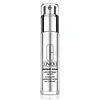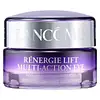What's inside
What's inside
 Key Ingredients
Key Ingredients

 Benefits
Benefits

 Concerns
Concerns

 Ingredients Side-by-side
Ingredients Side-by-side

Water
Skin ConditioningIsododecane
EmollientDimethicone
EmollientCyclopentasiloxane
EmollientPolysilicone-11
Butylene Glycol
HumectantAscorbyl Glucoside
AntioxidantPEG-10 Dimethicone
Skin ConditioningPEG-6
HumectantCitrus Grandis Peel Extract
AstringentMorus Nigra Root Extract
Skin ConditioningHordeum Vulgare Extract
EmollientScutellaria Baicalensis Root Extract
AstringentCucumis Sativus Fruit Extract
EmollientHydrolyzed Rice Bran Extract
Skin ConditioningGentiana Lutea Root Extract
Skin ConditioningAlgae Extract
EmollientPlankton Extract
Skin ConditioningVitis Vinifera Fruit Extract
Skin ConditioningSigesbeckia Orientalis Extract
Skin ConditioningTriticum Vulgare Germ Extract
Skin ConditioningGlycerin
HumectantOryza Sativa Bran Extract
Skin ConditioningYeast Extract
Skin ConditioningAcetyl Hexapeptide-8
HumectantPalmitoyl Oligopeptide
CleansingErgothioneine
AntioxidantLactis Proteinum
Skin ConditioningPolysorbate 20
EmulsifyingMicrococcus Lysate
Skin ConditioningCholesterol
EmollientDi-C12-18 Alkyl Dimonium Chloride
Skin ConditioningSalicylic Acid
MaskingIsohexadecane
EmollientPropylene Glycol Dicaprate
EmollientHelianthus Annuus Seedcake
AbrasiveCaffeine
Skin ConditioningGlycine Soja Protein
EmulsifyingTocopheryl Acetate
AntioxidantAcetyl Glucosamine
Skin ConditioningCaprylyl Glycol
EmollientGlyceryl Polymethacrylate
Dimethoxytolyl Propylresorcinol
AntioxidantSynthetic Fluorphlogopite
Glycyrrhetinic Acid
Skin ConditioningTromethamine
BufferingPolysorbate 80
EmulsifyingSodium Hyaluronate
HumectantSodium Rna
Skin ConditioningSqualane
EmollientAminopropyl Ascorbyl Phosphate
AntioxidantAmmonium Acryloyldimethyltaurate/Vp Copolymer
PEG-8
HumectantLecithin
EmollientHexylene Glycol
EmulsifyingAcrylamide/Sodium Acryloyldimethyltaurate Copolymer
Emulsion StabilisingSodium Hydroxide
BufferingTin Oxide
AbrasiveDisodium EDTA
Phenoxyethanol
PreservativeCI 19140
Cosmetic ColorantCI 14700
Cosmetic ColorantCI 77891
Cosmetic ColorantPalmitoyl Hexapeptide-12
Skin ConditioningCalcium Chloride
AstringentSea Whip Extract
Skin ConditioningWater, Isododecane, Dimethicone, Cyclopentasiloxane, Polysilicone-11, Butylene Glycol, Ascorbyl Glucoside, PEG-10 Dimethicone, PEG-6, Citrus Grandis Peel Extract, Morus Nigra Root Extract, Hordeum Vulgare Extract, Scutellaria Baicalensis Root Extract, Cucumis Sativus Fruit Extract, Hydrolyzed Rice Bran Extract, Gentiana Lutea Root Extract, Algae Extract, Plankton Extract, Vitis Vinifera Fruit Extract, Sigesbeckia Orientalis Extract, Triticum Vulgare Germ Extract, Glycerin, Oryza Sativa Bran Extract, Yeast Extract, Acetyl Hexapeptide-8, Palmitoyl Oligopeptide, Ergothioneine, Lactis Proteinum, Polysorbate 20, Micrococcus Lysate, Cholesterol, Di-C12-18 Alkyl Dimonium Chloride, Salicylic Acid, Isohexadecane, Propylene Glycol Dicaprate, Helianthus Annuus Seedcake, Caffeine, Glycine Soja Protein, Tocopheryl Acetate, Acetyl Glucosamine, Caprylyl Glycol, Glyceryl Polymethacrylate, Dimethoxytolyl Propylresorcinol, Synthetic Fluorphlogopite, Glycyrrhetinic Acid, Tromethamine, Polysorbate 80, Sodium Hyaluronate, Sodium Rna, Squalane, Aminopropyl Ascorbyl Phosphate, Ammonium Acryloyldimethyltaurate/Vp Copolymer, PEG-8, Lecithin, Hexylene Glycol, Acrylamide/Sodium Acryloyldimethyltaurate Copolymer, Sodium Hydroxide, Tin Oxide, Disodium EDTA, Phenoxyethanol, CI 19140, CI 14700, CI 77891, Palmitoyl Hexapeptide-12, Calcium Chloride, Sea Whip Extract
Water
Skin ConditioningTheobroma Cacao Seed Butter
EmollientDimethicone
EmollientGlycerin
HumectantIsohexadecane
EmollientPropanediol
SolventAlcohol Denat.
AntimicrobialGlyceryl Stearate
EmollientPEG-20 Stearate
EmulsifyingPEG/PPG/Polybutylene Glycol-8/5/3 Glycerin
HumectantStearic Acid
CleansingPEG-100 Stearate
Palmitic Acid
EmollientOctyldodecanol
EmollientCI 77891
Cosmetic ColorantCI 17200
Cosmetic ColorantC13-14 Isoparaffin
EmollientGuanosine
Skin ConditioningMica
Cosmetic ColorantSecale Cereale Seed Extract
AbrasiveSodium Acetylated Hyaluronate
HumectantHydrolyzed Soy Protein
HumectantHydrolyzed Linseed Extract
Skin ConditioningSodium Hydroxide
BufferingSodium Benzoate
MaskingPhenoxyethanol
PreservativeAdenosine
Skin ConditioningAcetyl Tetrapeptide-9
Skin ConditioningCaffeine
Skin ConditioningTrisodium Ethylenediamine Disuccinate
Polyacrylamide
Dimethiconol
EmollientLimonene
PerfumingPentylene Glycol
Skin ConditioningPentaerythrityl Tetra-Di-T-Butyl Hydroxyhydrocinnamate
AntioxidantTin Oxide
AbrasiveBenzyl Alcohol
PerfumingCaprylyl Glycol
EmollientCapryloyl Salicylic Acid
ExfoliatingMyristic Acid
CleansingGeraniol
PerfumingLaureth-7
EmulsifyingParfum
MaskingWater, Theobroma Cacao Seed Butter, Dimethicone, Glycerin, Isohexadecane, Propanediol, Alcohol Denat., Glyceryl Stearate, PEG-20 Stearate, PEG/PPG/Polybutylene Glycol-8/5/3 Glycerin, Stearic Acid, PEG-100 Stearate, Palmitic Acid, Octyldodecanol, CI 77891, CI 17200, C13-14 Isoparaffin, Guanosine, Mica, Secale Cereale Seed Extract, Sodium Acetylated Hyaluronate, Hydrolyzed Soy Protein, Hydrolyzed Linseed Extract, Sodium Hydroxide, Sodium Benzoate, Phenoxyethanol, Adenosine, Acetyl Tetrapeptide-9, Caffeine, Trisodium Ethylenediamine Disuccinate, Polyacrylamide, Dimethiconol, Limonene, Pentylene Glycol, Pentaerythrityl Tetra-Di-T-Butyl Hydroxyhydrocinnamate, Tin Oxide, Benzyl Alcohol, Caprylyl Glycol, Capryloyl Salicylic Acid, Myristic Acid, Geraniol, Laureth-7, Parfum
Ingredients Explained
These ingredients are found in both products.
Ingredients higher up in an ingredient list are typically present in a larger amount.
Caffeine is most associated with coffee, tea, and cacao. In skincare, it helps with calming inflammation and is rich in antioxidants.
While caffeine is used to treat cellulite and and dark circles, further studies are needed to prove this. It has been believed to help with these skin conditions due to its ability to dilate blood vessels and increase blood flow.
Some studies are looking into caffeine's ability to protect against UV rays.
Learn more about CaffeineCaprylyl Glycol is a humectant and emollient, meaning it attracts and preserves moisture.
It is a common ingredient in many products, especially those designed to hydrate skin. The primary benefits are retaining moisture, skin softening, and promoting a healthy skin barrier.
Though Caprylyl Glycol is an alcohol derived from fatty acids, it is not the kind that can dry out skin.
This ingredient is also used as a preservative to extend the life of products. It has slight antimicrobial properties.
Learn more about Caprylyl GlycolCi 77891 is a white pigment from Titanium dioxide. It is naturally found in minerals such as rutile and ilmenite.
It's main function is to add a white color to cosmetics. It can also be mixed with other colors to create different shades.
Ci 77891 is commonly found in sunscreens due to its ability to block UV rays.
Learn more about CI 77891Dimethicone is a type of synthetic silicone created from natural materials such as quartz.
What it does:
Dimethicone comes in different viscosities:
Depending on the viscosity, dimethicone has different properties.
Ingredients lists don't always show which type is used, so we recommend reaching out to the brand if you have questions about the viscosity.
This ingredient is unlikely to cause irritation because it does not get absorbed into skin. However, people with silicone allergies should be careful about using this ingredient.
Note: Dimethicone may contribute to pilling. This is because it is not oil or water soluble, so pilling may occur when layered with products. When mixed with heavy oils in a formula, the outcome is also quite greasy.
Learn more about DimethiconeGlycerin is already naturally found in your skin. It helps moisturize and protect your skin.
A study from 2016 found glycerin to be more effective as a humectant than AHAs and hyaluronic acid.
As a humectant, it helps the skin stay hydrated by pulling moisture to your skin. The low molecular weight of glycerin allows it to pull moisture into the deeper layers of your skin.
Hydrated skin improves your skin barrier; Your skin barrier helps protect against irritants and bacteria.
Glycerin has also been found to have antimicrobial and antiviral properties. Due to these properties, glycerin is often used in wound and burn treatments.
In cosmetics, glycerin is usually derived from plants such as soybean or palm. However, it can also be sourced from animals, such as tallow or animal fat.
This ingredient is organic, colorless, odorless, and non-toxic.
Glycerin is the name for this ingredient in American English. British English uses Glycerol/Glycerine.
Learn more about GlycerinIsohexadecane is added to enhance texture, emulsify, and to help cleanse. It is an isoparrafin. It is a component of petrolatum.
Due to its large size, Isohexadecane is not absorbed by the skin. Instead, it sits on top and acts as an emollient. Emollients help keep your skin soft and smooth by trapping moisture within.
Isohexadecane is often used in products designed to help oily skin. It is lightweight and non-greasy while helping to moisturize. When mixed with silicones, it gives a product a silky feel.
Learn more about IsohexadecanePhenoxyethanol is a preservative that has germicide, antimicrobial, and aromatic properties. Studies show that phenoxyethanol can prevent microbial growth. By itself, it has a scent that is similar to that of a rose.
It's often used in formulations along with Caprylyl Glycol to preserve the shelf life of products.
Sodium Hydroxide is also known as lye or caustic soda. It is used to adjust the pH of products; many ingredients require a specific pH to be effective.
In small amounts, sodium hydroxide is considered safe to use. However, large amounts may cause chemical burns due to its high alkaline.
Your skin has a natural pH and acid mantle. This acid mantle helps prevent harmful bacteria from breaking through. The acid mantle also helps keep your skin hydrated.
"Alkaline" refers to a high pH level. A low pH level would be considered acidic.
Learn more about Sodium HydroxideTin Oxide is an inorganic oxide used to add opacity and volume to a product. In nature, it is already found in mineral form. The main ore of tin is an opaque and shiny mineral called casseterite.
Tin Oxide helps remove translucency in a product, or make it more opaque. Besides adding opacity, tin oxide is used for bulking to add volume.
Water. It's the most common cosmetic ingredient of all. You'll usually see it at the top of ingredient lists, meaning that it makes up the largest part of the product.
So why is it so popular? Water most often acts as a solvent - this means that it helps dissolve other ingredients into the formulation.
You'll also recognize water as that liquid we all need to stay alive. If you see this, drink a glass of water. Stay hydrated!
Learn more about Water